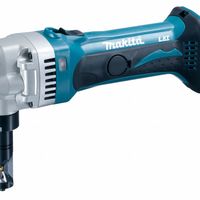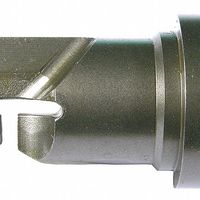Call +(254) 703 030 000 / 751 483 999 / 721 704 777
- Home
- Tools
- Power Tools
- Power Shears Nibblers
- Power Nibblers For Sheet Metal
.....Read More
Frequently Asked Questions
What is a power nibbler used for?
A power nibbler is a versatile cutting tool used primarily for sheet metal work. It is designed to cut through metal sheets with precision and ease, making it an essential tool in various industries such as automotive, construction, and metal fabrication. The power nibbler operates by using a punch-and-die mechanism, where a rapidly moving punch cuts small, crescent-shaped pieces from the metal sheet, allowing for intricate and precise cuts without distorting the material.
One of the key advantages of a power nibbler is its ability to cut complex shapes and curves, which is particularly useful in applications requiring detailed metalwork. Unlike other cutting tools, such as shears or saws, nibblers do not produce heat during the cutting process, minimizing the risk of warping or damaging the material. This makes them ideal for cutting thin metal sheets, aluminum, and even some plastics.
Power nibblers are available in various forms, including electric, pneumatic, and manual versions, catering to different needs and preferences. Electric and pneumatic nibblers are more common in professional settings due to their efficiency and ease of use, while manual nibblers are suitable for smaller, less demanding tasks.
In addition to their precision and versatility, power nibblers are valued for their ability to produce clean cuts with minimal burrs, reducing the need for additional finishing work. This efficiency makes them a preferred choice for tasks such as cutting roofing sheets, automotive body panels, and HVAC ductwork.
Overall, a power nibbler is an indispensable tool for anyone involved in metalworking, offering a combination of precision, efficiency, and versatility that is hard to match with other cutting tools.
How does a power nibbler work?
A power nibbler is a tool used for cutting sheet metal with precision and ease. It operates by using a punch-and-die mechanism to remove small bits of metal, or "nibbles," from the workpiece. The tool consists of a motor, a punch, a die, and a handle or trigger for operation.
When activated, the motor drives the punch in a rapid up-and-down motion. The punch is aligned with a die, which is a stationary component with a hole that matches the shape of the punch. As the punch moves down, it shears a small piece of metal through the die, creating a clean cut. This process is repeated rapidly, allowing the nibbler to cut through the metal efficiently.
The nibbler is guided along the desired cutting path by the operator, who can maneuver it to create straight lines, curves, or intricate shapes. The small size of the nibbles allows for tight turns and detailed cuts, making the tool ideal for complex patterns and designs.
Power nibblers are available in various forms, including electric, pneumatic, and manual versions. Electric and pneumatic nibblers are more common for industrial applications due to their speed and power, while manual nibblers are suitable for lighter tasks.
The key advantages of a power nibbler include minimal distortion of the metal, the ability to cut in any direction, and the production of clean edges without burrs. These features make it a preferred tool for metalworking tasks such as automotive bodywork, HVAC ductwork, and sheet metal fabrication.
What materials can a power nibbler cut?
A power nibbler is a versatile tool used for cutting various materials, primarily sheet metals. It is particularly effective for:
1. **Steel**: Power nibblers can cut through mild steel sheets, typically up to 10 gauge (about 3.4 mm) thickness, depending on the model and power of the nibbler.
2. **Stainless Steel**: They can also handle stainless steel, though usually at a slightly reduced thickness compared to mild steel, often up to 12 gauge (about 2.7 mm).
3. **Aluminum**: Aluminum sheets are easily cut by power nibblers, often up to 8 gauge (about 4 mm) due to aluminum's softer nature.
4. **Copper**: Copper sheets can be cut with ease, similar to aluminum, given its malleability.
5. **Brass**: Brass sheets are also suitable for cutting with a power nibbler, as it is a softer metal.
6. **Plastic**: Certain plastics, especially those used in industrial applications, can be cut with a power nibbler, provided they are not too brittle.
7. **Fiberglass**: Some power nibblers can cut through fiberglass sheets, though care must be taken to avoid splintering.
8. **Other Sheet Metals**: Power nibblers can handle various other sheet metals used in construction and manufacturing, such as galvanized steel and tin.
The effectiveness of a power nibbler in cutting these materials depends on the tool's specifications, including its power, the type of die and punch used, and the thickness of the material. Always refer to the manufacturer's guidelines for specific capabilities and limitations.
What are the advantages of using a power nibbler over other cutting tools?
A power nibbler offers several advantages over other cutting tools:
1. **Precision and Control**: Power nibblers provide precise cutting capabilities, allowing for intricate shapes and patterns without distorting the material. This precision is particularly beneficial for detailed work in sheet metal fabrication.
2. **Minimal Material Distortion**: Unlike shears or saws, nibblers cut without bending or warping the material, maintaining the integrity and flatness of the workpiece. This is crucial for applications requiring high-quality finishes.
3. **Versatility**: Power nibblers can cut a variety of materials, including steel, aluminum, and other metals, as well as plastics. They are suitable for both straight cuts and complex curves, making them versatile for different projects.
4. **Speed and Efficiency**: Nibblers are faster than manual cutting tools and can handle large volumes of work quickly. This efficiency reduces labor time and increases productivity, especially in industrial settings.
5. **Reduced Heat Generation**: Unlike some cutting tools that generate significant heat, nibblers produce minimal heat, reducing the risk of material damage or warping due to thermal expansion.
6. **Cleaner Cuts**: The cutting action of a nibbler results in clean edges with minimal burrs, reducing the need for additional finishing processes and saving time.
7. **Safety**: Power nibblers are generally safer to use than some other cutting tools, as they produce fewer sparks and less debris. This reduces the risk of injury and the need for extensive protective measures.
8. **Portability**: Many power nibblers are lightweight and portable, making them easy to maneuver and ideal for on-site work or in confined spaces where larger tools may not fit.
Overall, power nibblers offer a combination of precision, efficiency, and versatility, making them a preferred choice for many metalworking and fabrication tasks.
How do you maintain a power nibbler?
To maintain a power nibbler, follow these steps:
1. **Regular Cleaning**: After each use, clean the nibbler to remove metal shavings and debris. Use a brush or compressed air to clear the cutting head and vents.
2. **Lubrication**: Apply a light machine oil to the moving parts, especially the cutting head and punch, to reduce friction and prevent rust.
3. **Inspect Cutting Head**: Regularly check the cutting head and punch for wear and tear. Replace them if they become dull or damaged to ensure clean cuts and prevent motor strain.
4. **Check Fasteners**: Ensure all screws and bolts are tight. Loose components can affect performance and safety.
5. **Motor Maintenance**: Periodically inspect the motor for overheating or unusual noises. Clean the motor housing to prevent dust accumulation.
6. **Cord and Plug Inspection**: Examine the power cord and plug for any signs of damage. Replace immediately if any fraying or cuts are found to prevent electrical hazards.
7. **Storage**: Store the nibbler in a dry, dust-free environment. Use a protective case if available to prevent physical damage.
8. **Follow Manufacturer’s Guidelines**: Adhere to the maintenance schedule and guidelines provided in the user manual for specific care instructions.
9. **Sharpening**: If applicable, sharpen the cutting blades according to the manufacturer's instructions to maintain cutting efficiency.
10. **Test Functionality**: Before each use, test the nibbler to ensure it operates smoothly without unusual vibrations or sounds.
By following these maintenance steps, you can extend the lifespan of your power nibbler and ensure it operates efficiently and safely.
What is the difference between corded and cordless nibblers?
Corded nibblers are powered by electricity through a direct connection to a power outlet. They offer consistent power output, making them suitable for heavy-duty tasks and prolonged use without the need for recharging. Corded nibblers are generally more powerful, providing higher cutting speeds and efficiency, which is ideal for industrial applications or when working with thicker materials. However, their mobility is limited by the length of the power cord, and they require access to an electrical outlet, which can be a constraint in remote or outdoor locations.
Cordless nibblers, on the other hand, are battery-powered, offering greater portability and flexibility. They are ideal for use in areas without easy access to power outlets or for tasks that require frequent movement. The absence of a cord reduces the risk of tripping hazards and allows for easier maneuverability in tight spaces. However, cordless nibblers are typically less powerful than their corded counterparts and are limited by battery life, requiring periodic recharging or battery replacement. They are best suited for lighter tasks or for use in locations where mobility is a priority.
In summary, the main differences between corded and cordless nibblers lie in their power source, mobility, and suitability for different tasks. Corded nibblers offer consistent power and are better for heavy-duty applications, while cordless nibblers provide greater flexibility and are more convenient for use in various locations, albeit with some limitations in power and runtime.
How do you replace the punches and dies on a power nibbler?
1. **Safety First**: Ensure the power nibbler is unplugged or disconnected from its power source to prevent accidental activation.
2. **Access the Punch and Die**: Remove any protective covers or guards to access the punch and die area. This may require unscrewing or unclipping parts of the housing.
3. **Remove the Punch**:
- Locate the punch holder or clamp.
- Loosen the securing bolt or screw using the appropriate tool, often an Allen wrench or screwdriver.
- Carefully slide out the punch from its holder.
4. **Remove the Die**:
- Identify the die holder, usually located beneath the punch.
- Loosen the securing mechanism, which may involve unscrewing bolts or releasing a clamp.
- Lift or slide out the die from its position.
5. **Inspect Components**: Check the removed punch and die for wear or damage. Clean the area to remove any debris or metal shavings.
6. **Install New Die**:
- Position the new die in the holder, ensuring it aligns correctly with the punch.
- Secure it by tightening the bolts or clamps.
7. **Install New Punch**:
- Insert the new punch into the holder, ensuring it is aligned properly with the die.
- Tighten the securing bolt or screw to hold the punch in place.
8. **Reassemble and Test**:
- Reattach any covers or guards that were removed.
- Reconnect the power source and perform a test run on scrap material to ensure proper operation and alignment.
9. **Final Adjustments**: Make any necessary adjustments to ensure the punch and die are functioning smoothly and efficiently.


